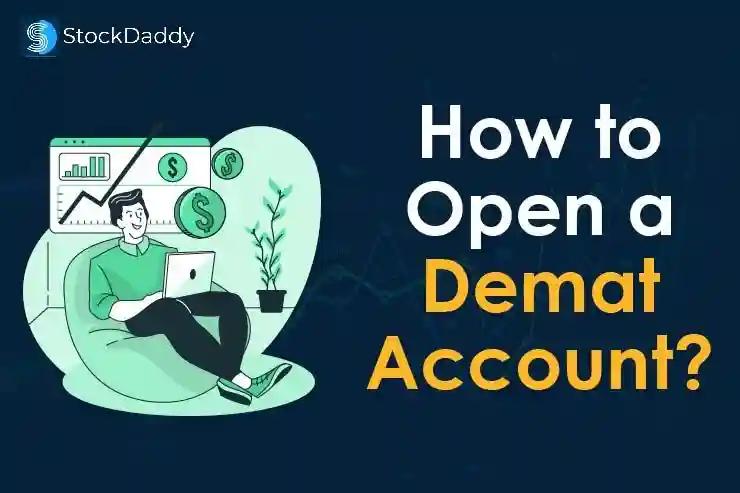Blog >
How to open Demat Account?
How to open Demat Account?

Investors can use a Demat Account to hold shares and securities in digital or electronic format. The meaning of a Demat account is a Dematerialized Account. In India, Depository Participants (DPs) manage Demat accounts, and there are two DPs: NSDL (National Securities Depository Limited) and CDSL (Central Depository Services Limited). In this blog, you get to know about how to open a Demat account, its types, the offline and online activating process of the Demat account, and the documents you require for the verification.
What is a Demat account?
A Demat Account, also known as a Dematerialised Account, is an electronic account that allows investors to keep shares and assets in a digital format. Shares are purchased and held in a Demat Account during online trading, allowing users to trade quickly and easily. This account facilitates and allows investors to hold all the investments that he/she makes in stocks, government securities, exchange-traded funds, bonds, and mutual funds.
There are so many places from where you can open your Demat account are HDFC Demat account, axis bank Demat account, Kotak Demat account SBI Demat account, icici Demat account, etc.
Usually, there is only a maintenance fee charged by Depository Participants (DPs) and the charges depend on the DP and their policies.
And you can open a Demat account with stockDaddy.
What is dematerialization, and how does it work?
The process of changing physical share certificates into electronic form, which is much easier to maintain and available from anywhere in the globe, is known as dematerialization. To trade online, an investor must first open a Demat account (you can also open a free Demat account) with a Depository Participant (DP). The goal of dematerialization is to make it easier for investors to maintain and monitor their holdings by eliminating the need for them to hold physical share certificates.
How many types of Demat accounts?
Depending on the investor's residency status, there are three types of Demat accounts that can be opened in India:
- Regular Demat account: All investors in India can open a regular Demat account. You can open an account with any depository participant (DP) of your choice. The main distinction between a regular Demat account and the others is that it does not have additional features such as foreign fund transfers.
- Repatriable Demat account: This sort of Demat account is available to NRIs who have a non-resident rupee account (NRE). This account enables international money transfers.
- Non-repatriable Demat account: This sort of Demat account can be opened by non-resident Indians who have a non-resident ordinary rupee (NRO) account. However, this account is restricted to international money transfers.
What is the procedure for opening a Demat account offline?
Fortunately, starting a Demat account is simple. It's possible to do it both offline and online. Let's look at how to open a Demat account performing offline procedures.
1). Choose a Depository Participant (DP)
You can choose the most suited DP for your needs after comparing the services and benefits given by various DPS.
2). Complete the application form.
To open a new Demat account, you will need to fill out an application form. Also, you'll need to submit a list of KYC documents, including identity proof, address proof, PAN card, bank account information, and personal information.
3). The procedure for verification
You will be provided with a list of laws and regulations to ensure ethical and legal trading, as well as to dispel any worries you may have about having a Demat account and the various duties it performs. The DP will verify you and your KYC documents by conducting a face-to-face meeting. Any fees related to opening a Demat account must be paid. The cost is set by the DP's current policy.
4). Obtain final approval
Your new Demat account will be opened after your documents have been confirmed and the final processes have been fulfilled. You will also be provided with your account's Unique Identification Number.
What is the procedure for opening a Demat account online?
It is possible to open a Demat account in a more easy approach. You can open a Demat account in a few minutes with just a computer, laptop, tablet, or smartphone.
To open a Demat account online, follow the steps below:
- Go to your DP's official webpage.
- Simply provide your name, phone number, and city of residence in the quick lead form. Your registered contact number will thereafter receive an OTP.
- To proceed to the next form, you must first enter your OTP. Fill out your KYC information, which includes your date of birth, PAN card number, contact information, and bank account number.
- Your depository account has been activated! On your email and phone, you will receive information regarding your Demat account number.
A Demat account is a type of investment account that allows a person to hold numerous securities. These accounts can be linked to the same DP or separate DPS. Investors can open several Demat accounts as long as they can provide the necessary KYC information for all applications.
Investors' Eligibility
Anyone who is a legal resident of India and has the appropriate papers can open a Demat account in the country. Non-resident Indians can open a Demat account, although there are some limits imposed by SEBI.
There can be three account holders in a Demat account: two joint account holders and one primary account holder.
There is a provision to name a beneficiary in the event of death. Each account holder is urged to name a beneficiary in the case of joint accounts. The account holder's nominee can be changed or modified.
The following is a list of documents that are accepted for KYC
Certain documentation will be required to open a Demat account. One identification proof and one address proof will be required. The following is a list of acceptable documents that can be used:
Identity proof documents list:
- Verified copy of electricity/phone bill
- PAN card
- Bank attestation
- A photo ID card issued by a central or state government body
- ICAI, ICWAI, ICSI, bar council etc, issued identification cards with a photographs
- passport
- driver's license
- voter's ID
- IT returns
Address proof documents list
- Bank passbook/ bank statement
- Leave and license agreement/ agreement for sale,
- Verified copies of residential telephone/ electricity bills
- Voter’s ID
- Ration card
- Passport
- Driving license
Wrap-Up!
Your trading account is tied to your Demat account, which is linked to your bank account. You must first transfer funds from your bank account to your trading account before you can begin trading. You can use your trading account to place an order to acquire shares after adding funds. The shares will be transferred to your Demat Account by the end of T+2 days after the order is performed but in 2022, it will be done by the end of T+ 1 Settlement Cycle days, where T is the day the transaction was executed.
All of these actions happen quickly and seamlessly since the Demat and Trading Accounts are strongly amalgamated. Similarly, you can sell a share in your Demat Account by using your Trading Account to place a sell order on the stock exchange.

- Recent Blogs
- What is gold Bees ETF and How to invest in it?
- Difference Between Call and Put Option
- Types of Charts in Stock Market
- what is CPSE etf and How is it a good investment Opportunity
- What is Margin Trading Facility
- why Tata Motors Share is Falling?
- Disadvantages of SIP Investment You Should Know
- Can Stock Market make you Rich?
- Difference Between Sensex and Nifty
- Difference Between Fundamental Analysis and Technical Analysis